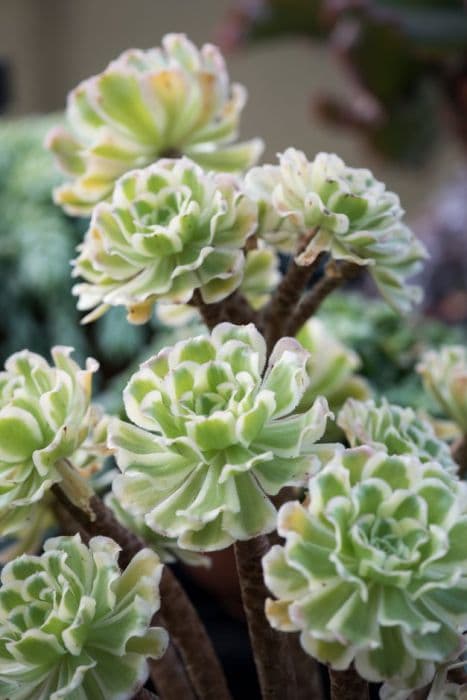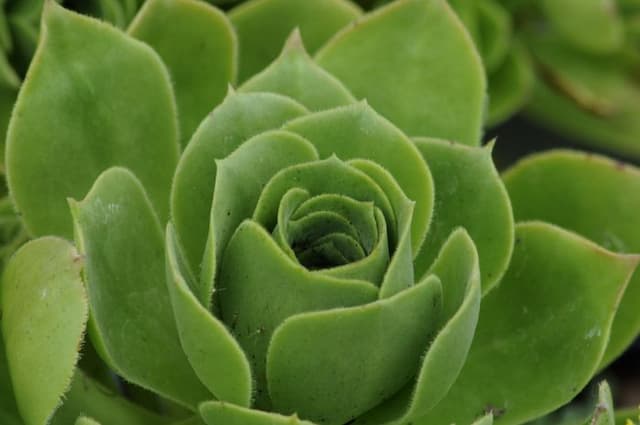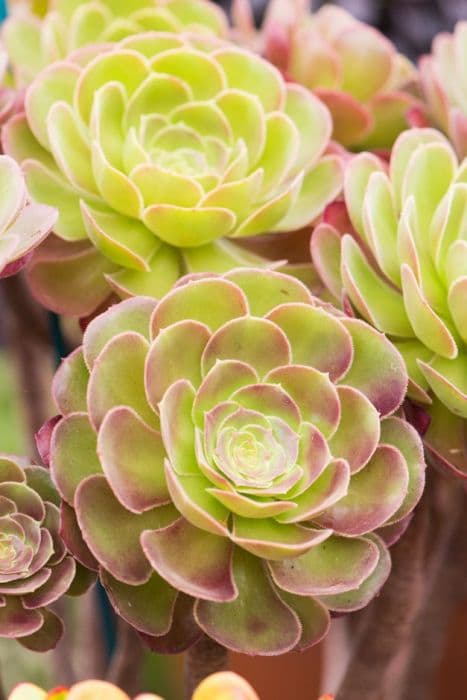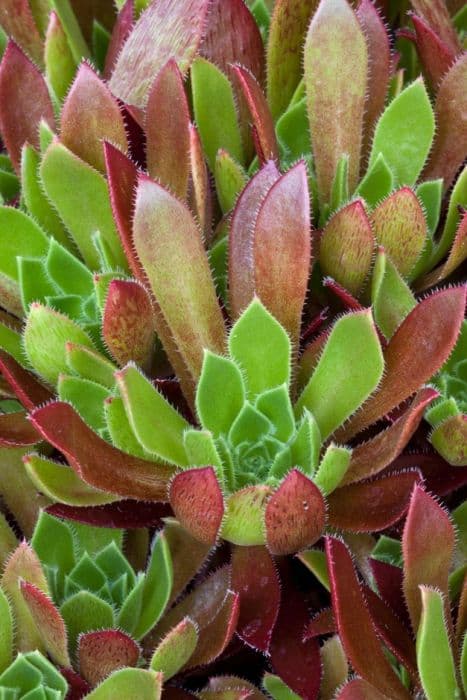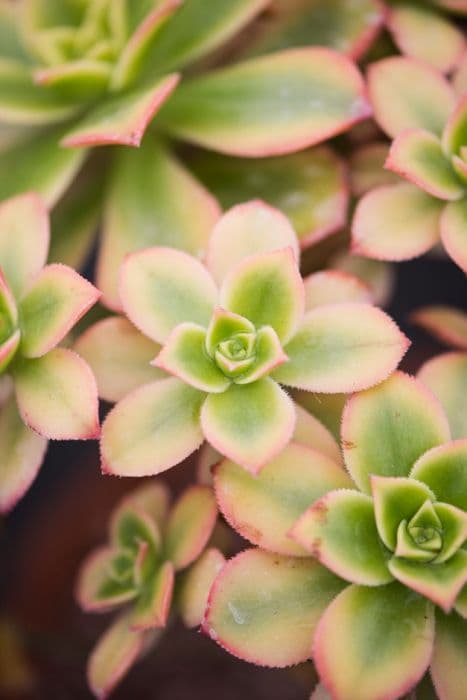Houseleek 'Blood Tip' Sempervivum 'Blood Tip'

ABOUT
'Blood Tip' is a mat-forming, evergreen perennial with clusters of fleshy rosettes to 10cm in width, the leaves are blue-green with variable amounts of deep red on the tips. Sprays of starry pink flowers are produced on stout stems up to 20cm tall in summer
About this plant
 Names
NamesSynonyms
Hen And Chicks, Houseleeks.
Common names
Sempervivum 'Blood Tip'
 Characteristics
CharacteristicsFoliage type
Evergreen
Color of leaves
Green
Flower color
Pink
Height
0.5 feet (15 cm)
Spread
1 foot (30 cm)
Plant type
Succulent
Hardiness zones
5
Native area
Europe
Benefits
 General Benefits
General Benefits- Low Maintenance: The Blood Tip Succulent requires minimal care, making it ideal for busy individuals or those new to gardening.
- Drought Tolerant: As a succulent, it is exceptionally drought tolerant, storing water in its leaves for extended periods.
- Cold Hardy: This plant is resistant to colder temperatures, able to survive in USDA zones 3-8, making it suitable for a variety of climates.
- Attractive Aesthetics: Blood Tip Succulents have eye-catching rosettes with red-tipped leaves, providing visual interest in the garden or home.
- Garden Versatility: They can be grown in rock gardens, green roofs, borders, or as groundcover, adding texture and color contrasts.
- Propagation Ease: These plants can be easily propagated from offsets, allowing gardeners to create more plants for use or sharing.
- Insect Resistance: Blood Tip Succulents are not prone to many pests, reducing the need for pesticides.
- Long Living: Being a perennial, they can live for many years, offering long-term enjoyment.
- Year-Round Interest: The succulent maintains its structure and appeal throughout the seasons.
- Non-Invasive: They have a compact growing habit and do not spread aggressively, making them good neighbors to other plants.
 Medical Properties
Medical PropertiesThis plant is not used for medical purposes.
 Air-purifying Qualities
Air-purifying QualitiesThis plant is not specifically known for air purifying qualities.
 Other Uses
Other Uses- A substrate for miniature gardening: Because of its small and compact size, Sempervivum, also known as 'hen and chicks', can be used to create realistic miniature landscapes or fairy gardens.
- Cold hardy groundcover: 'Hen and chicks' can be used in areas with harsh winters as a reliable groundcover that can survive low temperatures and requires minimal maintenance.
- Living roof or green roof plants: This succulent is ideal for planting on roofs, as it is drought-tolerant and can help insulate the building, reducing energy costs.
- Livestock forage: In some areas, 'hen and chicks' is used as an emergency forage for livestock, especially in drought conditions where other food sources are scarce.
- Edible garnish: The leaves of some Sempervivum species are edible and can be used as an attractive, albeit unusual, garnish for food dishes.
- Companion planting in vegetable gardens: Their drought tolerance and dense growth can help to maintain soil moisture levels and suppress weeds around vegetable plants.
- Artistic arrangements: The symmetrical rosettes of 'hen and chicks' are often used in floral arrangements and as living art elements due to their form and color variations.
- Container gardens: They are ideal for containers because they are low maintenance and can add texture and interest to mixed plantings.
- Water-wise rock gardens: Their drought resistance makes them suitable for rock gardens designed to conserve water and create natural, rugged beauty in a landscape.
- Education and research: Sempervivum can be used in educational settings as an example of adaptations in plants for harsh, dry environments, and they are an interesting subject for horticultural studies.
Interesting Facts
 Feng Shui
Feng ShuiThe Hen and Chicks plant is not used in Feng Shui practice.
 Zodiac Sign Compitability
Zodiac Sign CompitabilityThe Hen and Chicks plant is not used in astrology practice.
 Plant Symbolism
Plant Symbolism- Resilience: Sempervivum, commonly known as Hen and Chicks, is known for its ability to thrive in harsh, rocky environments, symbolizing the ability to endure and persist through difficult conditions.
- Protection: With its rosette shape and thick leaves, Hen and Chicks embodies a natural shield-like quality, representing safeguarding and defense against adversity.
- Self-sufficiency: This plant can reproduce asexually, with the "chicks" growing around the "hen," which signifies independence and the capability to care for oneself without external help.
- Eternal love: Sempervivum means "live forever," which translates to a symbol of enduring love and immortality in plant symbolism, reflecting an everlasting bond.
- Maternal love: The growth pattern of Hen and Chicks, where the central "hen" supports and nourishes the surrounding "chicks," is seen as a representation of a mother's nurture and care for her offspring.
 Water
WaterHens and Chicks prefer to be watered deeply but infrequently. Allow the soil to dry out completely before watering again. This succulent is drought-tolerant, often needing no more than 0.25 gallons per plant every two to three weeks during active growth periods. In winter, watering can be reduced further to once a month or less, depending on your home's humidity levels. Be cautious not to overwater, as this can lead to root rot.
 Light
LightHens and Chicks thrive best in full sun to partial shade conditions. Providing them with at least six hours of direct sunlight daily is ideal. If grown indoors, place them near a south-facing window where they can receive ample sunlight.
 Temperature
TemperatureHens and Chicks are cold-hardy plants, they can survive in temperatures as low as -20°F and as high as 90°F, although they thrive best in temperatures ranging between 65°F and 75°F. Avoid extreme heat as it may cause the plant to go dormant.
 Pruning
PruningPruning Hens and Chicks is generally unnecessary, but removing dead leaves and spent flower stalks helps maintain plant health and appearance. Prune in the spring or early summer, as needed, to enhance the plant's vigor.
 Cleaning
CleaningAs needed
 Soil
SoilHens and Chicks prefer a well-draining soil mix of half potting soil and half gritty material like sand or perlite; the ideal pH level is around 6.0 to 7.0.
 Repotting
RepottingHens and Chicks should be repotted every two to three years to refresh the soil and accommodate growth.
 Humidity & Misting
Humidity & MistingHens and Chicks thrive in low to average humidity levels, typical of their native alpine habitat.
 Suitable locations
Suitable locationsIndoor
Place Hens and Chicks near a sunny window.
Outdoor
Plant Hens and Chicks in full sun to partial shade.
Hardiness zone
Hens and Chicks are hardy from USDA zones 3-8.
 Life cycle
Life cycleThe Sempervivum 'Blood Tip', commonly known as Hen and Chicks, begins its life as a small rosette, germinating from seed or more commonly growing from offsets of a parent plant. As it matures, the rosette grows larger and produces its own offsets, forming a dense cluster where each 'chick' is a replica of the 'hen' or mother plant. The plant thrives in well-draining soil with plenty of sunlight, entering a vigorous growth phase during the spring and summer. After several years, typically 3 to 4, the central rosette will flower once, producing a tall stalk with star-shaped blooms, signaling that this particular rosette is nearing the end of its lifecycle. Following flowering, that rosette will die back, making space for the surrounding offsets to fill in. The offsets continue the cycle, growing into new hens and producing more chicks to perpetuate the life of the colony.
 Propogation
PropogationPropogation time
Spring to Summer
The Sempervivum 'Blood Tip', commonly known as Hen and Chicks, is a succulent that can be effectively propagated during its growing season, which is spring and summer. The most popular method of propagation for this resilient plant is through division. Hen and Chicks produces offsets, commonly referred to as "chicks," which are small replicas growing around the base of the mother plant, commonly referred to as the "hen." These chicks can be carefully removed once they have grown to a size where they have developed their own roots. To propagate, gently pull the chicks away from the mother plant, ensuring each has a good root system attached. The removed offsets can be immediately replanted in well-draining soil, placed about an inch deep. Water them sparingly at first to encourage root growth and avoid rot, providing about a quarter cup (about 59 milliliters) of water per chick, and then gradually increase as the plant establishes.
